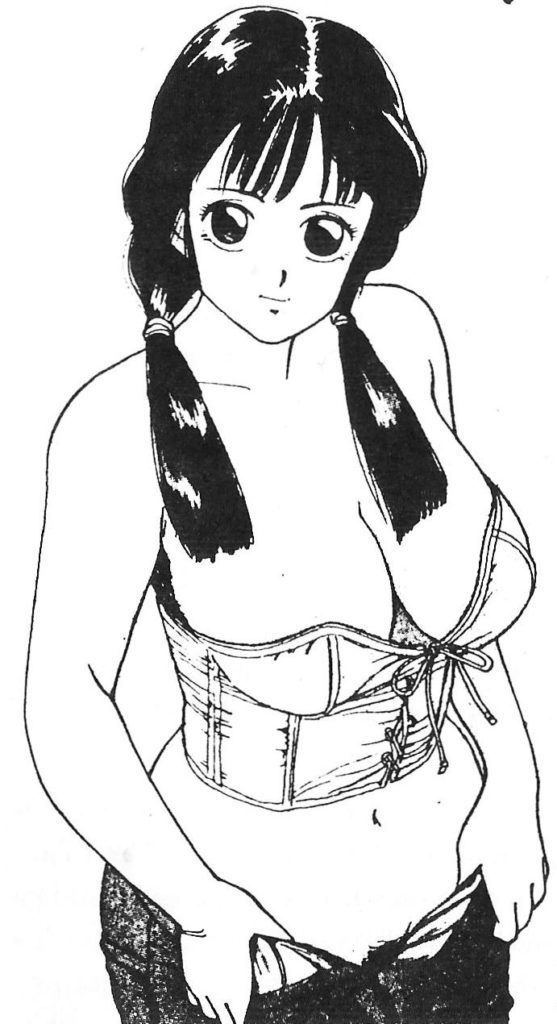The Women of Japan
by Peter “money is still my God” Payne
with additional thoughts by Peter “Studio Hell City” Evans
First, a self-introduction: My name is Peter Payne. I live at Maebashi, Japan. I am 24 years old. My hobby is to study kanji, play with Macintosh computers, and listen to the music.
But really. My name is Peter, and I’m from a very warm, balmy place called San Diego, California. Which makes me American, although my father is from Shipston-on-War (like, that sounds so British). He emigrated to the States in the 50s, so I’m officially Anglo-American. Some things I’ve learned since coming to Japan to “teach” “English” at an “English school” are: Australians will get offended if you say you can’t tell their accents apart from New Zealanders, Canadians will go agro if you ask them what state they’re from, and people from England–well, let’s just say that they certainly aren’t in favour of anyone with an accent like mine having anything to do with teaching. But since I’m really half British (though, as one friend put it, “my mouth is American”), you have to read this article.
I’ll admit it: I’ve wanted to write this kind of article ever since a friend of mine named Adam denounced Japanese women in Parachute Limit #1 (a ‘zine we publish in San Diego). But to write it before now would have been a fool’s errand, for the simple reason that I lacked qualification big-time. Before actually coming to Japan to live, I’d had almost as many stereotyped images of Japanese people as most of you reading these words, despite having studied the language for four years. Now that I’ve been through the fire, though, I think I can say that I’m ready to present the fairer sex of this country to you in the usual unbiased, laconic style which TC readers have become accustomed to.
Japanese Girls Next Door At first I was going to write an article about the Japan’s most beautiful women, her National Faces, when a friend of mine reminded me that the Seiko Matsudas and Rie Miyazawas are not actually representative of the women here–they’re exceptions. So I decided to expand my topic to include very day girls you’ll meet in the street, or at least, in English conversation classrooms
As a basic rule, Japanese women generally follow the same personality-dulling life-cycle as men. Cute innocence as children gives way to mediocrity in junior-high school as the assembly line-style Japanese education kicks in and fulfils the Japanese proverb ‘deru kui wa utareru’, “the standing nail is driven” (i.e., the nail which sticks out gets smashed down to be like all the others). As a result, the Japanese high school student’s idea of rebellion is wearing a hair ribbon or getting a perm in defiance of school rules. The pressures of studying to get into a good high school or college are generally less for girls than for boys, since, well, they’re girls, and they’re just going to get married and give up their careers anyway–but it is there for those with the drive to yearn for more than marriage and children.
Despite the racist view that Americans and Europeans (and sometimes me) like to take of Japanese people — that they are the human equivalents of worker ants — Japanese are quite individual. They have different interests, personalities, likes and dislikes. On the other hand, Japanese girls and women do tend to come in several different “flavours” or personality types, which I will now attempt to outline for you.

America Kabure: From ‘kabureru’, “to be influenced,” America Kabure-types are the ones influenced by US/European society so much that they actually wish they were from the land of baseball made in America, cheap stuff made in China and Apple computers made in Ireland. They dress like Americans, listen to Guns ‘n’ Roses, and frequently know more about 60’s pop culture than I do (which admittedly isn’t hard). They are also generally in the market for a gaijin boyfriend, if they don’t have one already, and of all Japanese girls are the most likely to go to bed with you just because you’re American [or British, hopefully – Ed.]. (See also Yellow Cab.)
Burriko: From ‘buru’, “to be false” and ‘ko’, “child,” burriko girls are overly-cute. A great deal of Japanese pop culture relies on the well-developed sense of kawaii (cute) in the Japanese, and these girls are the natural results. Burriko types make a conscious effort to act “cute”; they pout and make cute drawings on their desks and shriek “kawaii!” as a kind of sacrifice to the gods of girlish virginity.
[Commonly, an Office Lady who can be discussing astrophysics with you until the boss comes in, then it’s: “You want a paper clip? Oh, I’m so happy. Would you like a small one? A big one? What colour would you like? Here, have two paper clips! What about three paper clips?…”]
The Dud: Japanese girls who have no strong feelings one way or another about anything, aspire only to be thought of as “average Japanese girls” and who basically have no deep emotions, I call “duds.” They are, sadly, one of the more common personality types.
Ei-kaiwa no Himé: This means “English conversation princess,” and yes, it’s a word I coined. These girls, usually OLs (“office lady”) but occasionally girls in college, pay $20 and up per hour to study English conversation once a week at one of the many money-grubbing Ei-kaiwa schools in Japan. Sometimes it’s a sort of fashion statement–“Did I mention that I’m studying English conversation at Nani Nani English School on Thursday nights?”–but occasionally they have a genuine interest. (See also America Kabure.)
Tokyo Stylin’ Chicks: For whatever reason, girls in Tokyo are about nine times as pretty as girls in Gunma-ken, where I live. It happens every time I take the train to Ueno. By the time you reach Omiya, a city in-between where I live and Tokyo, you start to notice that there are beautiful women all around you. Coming back, you notice that the knee-high spike boots, the black leather and fake fur, the miniskirts and garters and peter pans and the ¥20,000 perms have somehow disappeared by the time you get to Omiya, and only the babushka-clad dogs from Gunma remain. (This is formally called the Wall of Omiya Effect.)
[Hmm, have to agree with the man. Still he missed out on the Roppongi Clones and the babes in the mega-trendy nightclubs: “That’s not a miniskirt, that’s a belt”. Yes, you really can see their knickers. Buh!]
High Miss: One interesting form of rebellion in this society are the small percentage of women who, for whatever reason, remain single past the age of 30 in defiance of the Japanese custom of teiki reiki, which dictates that the time for marriage is between 19 and 25. these women are called high miss or old miss, Japanese-English versions of what was once called an old maid in the West.
Yanki: Probably some kind of corruption on the word “yankee,” yanki refers to a more blatant class of Japanese rebel. Yanki are young Japanese male and female wanna-be toughs who attempt to dye their hair blonde (it invariably comes out orange) and act like they think Japanese society doesn’t want them to act (although, in reality, they are just catching a counter-current in Japanese culture and thus are conforming as strongly as they would be otherwise). The preferred clothing label for yanki girls is a Japanese maker called Miki House, for some reason. A more hard-core subset of yanki are the boso-zoku, the uniform-wearing loud-car-and-motorcycle-racing thugs introduced to Americans through the animated movie Akira.
While there are the occasional ties to the Japanese mafia and drugs, boso-zoku generally are content to roam Japanese festivals in their best military-style uniforms and driving round making noise with their modified vehicles to get their kicks. Despite the obvious drawbacks to people who like sleeping at night, I find myself respecting yanki-ism because they are the true “randoms” of Japan. When I see a well-fed, well-educated Japanese guy with a T-shirt bearing Malcolm X’s image and the words “ghetto culture,” I really have to shake my head. At least these ruffians are ruffians who have carved a cultural niche without carbon-copying the pop-culture of the West.
Yamato Nadeshiko: An old word which describes the “classic” Japanese woman, quiet and subservient to males, these women are thankfully rare. I say thankfully because nothing could be more boring than a woman who will tie her man’s shoes for him. Many a navy serviceman has bought home a Japanese wife thinking that she would wait on him hand and foot, only to find that he had married a stereotype. The opposite of Yamato Nadeshiko is Kakah-denka, women who are mentally stronger than their husbands, and have basically castrated them into submission. I have seen many more examples of the latter than the former, usually among American/Japanese marriages, and thus am a little wary of marrying into this culture.
Yellow Cab: An ugly word, Yellow Cab refers to Japanese girls, usually living outside of Japan, who are, well, easy to ride. Ridiculous as it may sound, it’s a pressing problem. I’ve seen the pattern more than once in the States: Japanese girl gets hung up on America, and goes there to live her obsession in much the same way as my being in Japan. Unfortunately, said girl doesn’t have that many friends, because she doesn’t know anyone in that city, or doesn’t speak English, or is a twit and shunned by Japanese companions. What does she do? She learns that by sleeping with anyone who’ll spend time with her, she can have what she thinks is missing. Despite danger from a host of you-know-whats, it indicates a general moral breakdown and is a sad phenomenon.
[Commonly used for space-case Office Ladies on pathetically short holidays with the mission objective of collecting a full spectrum of STDs in as short a period as possible. He’s right, it is an ugly word]
And now…Peter Presents: Best of Three Pretty Girls
I’ve talked about every day Japanese girls you can meet on the street; now I’ll present the three girls who are, IMHO, the most beautiful girls Japan has to offer.

Rie Miyazawa: A corporate entity that wants to succeed in this country needs three things: a nifty corporate slogan with matching corny slogan (something like ‘kimi no yume e’, “to your dream”), a head office in Tokyo with twice as many employees as really necessary, and a visible spokesperson–usually a beautiful model–which it can associate itself with. These girls aren’t just idols; they drive Japan’s domestic advertising machine.
Half-Dutch and half-Japanese, Rie Miyazawa certainly qualifies for the beautiful part. Far and away Japan’s Most Popular Face, she advertises “Super Cup” cup ramen, Edwin Jeans, Daihatsu’s “Opti” car, Panasonic’s “Selfie” stereo line and (with Arnold Schwarzenegger, known as “Schwa-chan” here) Aidamin ‘V’ vitamin drink. In November of 1991, Rie shocked Japan by releasing a collection of nude photos entitled Santa Fe (yes, I own a copy). She recently became engaged to be married to popular sumo wrestler Takahanada, only to be rendered “up in the air” by a challenge from the Sumo Association about Rie’s role as the wife of a major sumo wrestler and problems with Rie’s mother, the original Dragon Lady. If the Kennedys are America’s “royal family”, then Rie and Takahanada will certainly fill the same role in Japan if they get married.
Yuka Watanabe: Having just turned 21, the lovely Yuka Watanabe is far and away my favourite “Beppin Gal.” Beppin, with it’s spin-offs, Beppin School and Dela (Deluxe) Beppin), is a medium to high-end Japanese adult magazine which we got to see a great deal of thanks to all the Japanese smut we sold to anime fans [it’s a fair cop – Ed.] at Anime Expo ’92.
Yuka-chan (birthday 23/12/72, sign Capricorn) is 80 centimetres bust, 56 waist and 80 hip, and she’s 159 cm tall. Her blood type is B, and her first nude photo collection came out April 11, 1991. She collects fashion accessories and “tereka” (telephone cards–the Japanese do love to truncate words). You can write her at the Beppin Shinjuku-ku Aisumi-machi 13-10 Akebono-bashi K-1 Building 2F Eichi Shuppan-nai Yoko Family Club-kei 160. Damn that’s a hell of an address.
“Thanks to all my readers for staying with me for so long,” Ms. Watanabe said at Beppin’s 8th anniversary party. She then plugged her next photo book, entitled “Magic of Love.” “Please look at my body now that I’ve become an adult.”
Ai Ijima: Finally we get to A/V queen turned talento, the undisputed T-back queen of Japan, Ai Ijima. (English check: “A/V” refers to the adult video industry, and “T-back” refers to these sort of G-string-type panties which leave little to the imagination but can still be shown on TV). Ai’s current photo book is entitled “Ai My Me.” (“Ai” means love, thus this means “Love My Me.”)
She appears every once in a while in porno mags such as Beppin, Scholar, and The Best and stars on an entertainment-for-men TV show called Gilgamesh Night on TV Tokyo (channel 12) on Sunday mornings at 1:15 to 2:15, if you get Japanese TV for some reason. (This is the show which pits five scantily-clad girls against each other to see who could be first to melt penis-shaped blocks of ice with diamond rings encased inside using only their mouths.) According to “Gal’s Library,” the A/V “news and etc. source” section in Beppin, Ai recently donated her panties to charity, which were sold for ¥60,000. You will probably now be going, “How much money is ¥60,000?”…

(For copies of Parachute Limit, send 50¢ or something useless but interesting to Parachute Limit, c/o Max Callahan, 4122 Mt. Alifan #E San Diego 92111 USA.)
